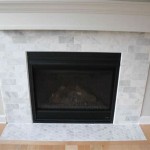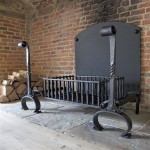Understanding Glass for Gas Fireplaces: A Comprehensive Guide
Gas fireplaces offer a convenient and efficient heating solution for many homes. Unlike traditional wood-burning fireplaces, gas fireplaces require no wood storage or tending to a fire, and they produce fewer emissions. A critical component of a gas fireplace is the glass enclosure, which serves multiple purposes, from safety to aesthetics. This article provides a detailed examination of the various types of glass used in gas fireplaces, their properties, maintenance requirements, and safety considerations.
The glass used in a gas fireplace is not ordinary window glass. It must withstand high temperatures generated by the gas flames and maintain its structural integrity over time. Consequently, manufacturers utilize specialized glass designed for these demanding conditions. The specific type of glass employed significantly impacts the fireplace's safety, efficiency, and visual appeal.
Types of Glass Used in Gas Fireplaces
Several types of glass are commonly used in gas fireplaces, each with its unique properties and advantages. Understanding these differences is essential when choosing a gas fireplace or replacing existing glass.
Tempered Glass: Tempered glass, also known as safety glass, is a common choice for gas fireplace enclosures. It undergoes a heat-treating process that makes it significantly stronger than standard annealed glass. This process involves heating the glass to a high temperature and then rapidly cooling it. This rapid cooling creates compressive stresses on the surface of the glass and tensile stresses within the core. As a result, tempered glass can withstand greater impacts and temperature fluctuations compared to annealed glass.
When tempered glass breaks, it shatters into small, relatively harmless fragments instead of sharp, dangerous shards. This characteristic greatly reduces the risk of serious injury. However, tempered glass is not indestructible. If subjected to extreme force or thermal shock, it can still shatter. It is important to note that tempered glass cannot be cut or modified after the tempering process. Any alterations must be made before the glass is treated.
Tempered glass offers a good balance of safety, durability, and cost-effectiveness, making it a widely used option for many gas fireplace models. Its ability to withstand high temperatures and its safer breakage pattern contribute to its popularity.
Ceramic Glass: Ceramic glass is specifically engineered to withstand extremely high temperatures, significantly higher than those tolerated by tempered glass. This type of glass is often found in high-efficiency gas fireplaces or those designed for prolonged use. Ceramic glass is not truly glass in the traditional sense but a type of ceramic material with glass-like properties.
The composition of ceramic glass includes a high percentage of silica and other components that contribute to its exceptional heat resistance. It can withstand continuous exposure to temperatures exceeding 1300 degrees Fahrenheit without significant deformation or degradation. This makes it ideal for fireplaces that generate intense heat. Unlike tempered glass, ceramic glass is less prone to shattering due to thermal shock.
While ceramic glass provides superior heat resistance, it tends to be more expensive than tempered glass. Its higher cost reflects the specialized manufacturing process and the unique properties of the material. Ceramic glass often exhibits slightly lower impact resistance compared to tempered glass. However, its primary advantage lies in its ability to endure extreme temperatures without compromising its structural integrity.
Borosilicate Glass: Borosilicate glass is another option known for its resistance to thermal shock and high temperatures. It contains boron trioxide, which gives it a low coefficient of thermal expansion. This means that borosilicate glass expands and contracts less when subjected to temperature changes, reducing the risk of cracking or shattering.
Borosilicate glass is commonly used in laboratory glassware and cookware due to its ability to withstand rapid temperature fluctuations. In gas fireplaces, it provides a balance between heat resistance and durability. While not as heat-resistant as ceramic glass, it offers better thermal shock resistance than tempered glass.
Borosilicate glass is typically more expensive than tempered glass but less expensive than ceramic glass. Its cost reflects its unique properties and the specialized manufacturing process. It is often found in higher-end gas fireplace models where thermal shock resistance is a primary concern.
Key Properties of Gas Fireplace Glass
Several key properties distinguish gas fireplace glass from ordinary glass and contribute to its suitability for this application. These properties include heat resistance, thermal shock resistance, and optical clarity.
Heat Resistance: This property refers to the glass's ability to withstand high temperatures without deforming, melting, or weakening. The heat resistance of glass is determined by its chemical composition and the manufacturing process. Ceramic glass offers the highest heat resistance, followed by borosilicate glass and then tempered glass. The appropriate choice of glass depends on the operating temperature of the gas fireplace.
Thermal Shock Resistance: Thermal shock resistance describes the glass's ability to withstand sudden temperature changes without cracking or shattering. Borosilicate glass exhibits the highest thermal shock resistance due to its low coefficient of thermal expansion. Ceramic glass also offers good thermal shock resistance, while tempered glass is more susceptible to thermal shock. The risk of thermal shock is higher in fireplaces that experience rapid temperature fluctuations.
Optical Clarity: Optical clarity refers to the glass's ability to transmit light without distortion or discoloration. All three types of glass—tempered, ceramic, and borosilicate—offer good optical clarity. However, the specific manufacturing process and the presence of any coatings can affect the clarity. Ensuring good optical clarity allows for an unobstructed view of the flames.
Beyond these key properties, other factors, such as impact resistance and scratch resistance, can also be relevant. Impact resistance refers to the glass's ability to withstand impacts without breaking. Tempered glass generally offers better impact resistance than ceramic glass. Scratch resistance refers to the glass's ability to resist scratches and abrasions. Proper cleaning and maintenance can help to maintain the clarity and appearance of the glass.
Maintenance and Safety Considerations
Proper maintenance and adherence to safety guidelines are crucial for ensuring the longevity and safe operation of a gas fireplace. Regular cleaning and inspection can help to prevent damage and ensure optimal performance.
Cleaning: Gas fireplace glass can accumulate soot, dust, and other deposits over time, reducing its clarity. Regular cleaning is essential to maintain a clear view of the flames. It is important to use a cleaning solution specifically designed for gas fireplace glass. These cleaners typically contain mild detergents and solvents that effectively remove soot and grime without damaging the glass.
Avoid using abrasive cleaners or scouring pads, as these can scratch the surface of the glass. Before cleaning the glass, ensure that the fireplace is completely cool. Applying cleaning solution to hot glass can cause it to crack or shatter. Follow the manufacturer's instructions for cleaning the glass, and use a soft cloth or sponge to wipe away the cleaner. Rinse the glass thoroughly with clean water and dry it with a lint-free cloth.
Inspection: Regularly inspect the glass for any signs of damage, such as cracks, chips, or scratches. Even small cracks can weaken the glass and increase the risk of shattering. If any damage is detected, replace the glass immediately. It is important to use replacement glass that meets the manufacturer's specifications. Using the wrong type of glass can compromise the safety and performance of the fireplace.
Safety: Always follow the manufacturer's safety instructions when operating a gas fireplace. Never touch the glass while the fireplace is in operation or immediately after it has been turned off, as it can remain hot for an extended period. Keep flammable materials away from the fireplace to prevent fire hazards. Ensure that the fireplace is properly vented to prevent the buildup of carbon monoxide. Install carbon monoxide detectors in your home and test them regularly.
Moreover, it's vital to ensure that the gas fireplace is installed by a qualified technician and that regular maintenance is performed by a professional. This includes checking the gas lines, burners, and venting system. Proper installation and maintenance can prevent gas leaks and other hazards.
Understanding the different types of glass used in gas fireplaces, their properties, and the importance of proper maintenance and safety practices is crucial for enjoying the benefits of a gas fireplace safely and efficiently. By following these guidelines, homeowners can ensure the longevity, safety, and aesthetic appeal of their gas fireplaces.

Fireplace Installation Instructions Diamond Fire Glass

Real Fyre Contemporary 30 Inch Vent Free Gas Fire Glass Set Insert Direct

Duluth Forge 28 In 55 000 Btu Direct Vented Natural Gas Fire Log Glass Burner Kit 210023 The Home Depot

Fire Pit Glass Everything You Need To Know

Duluth Forge Vent Free Stainless Outdoor Gas Fireplace Insert With Crystal Fire Glass Media 24 000 Btu 170094 The Home Depot

Majestic Black Reflective Glass Panels For 36 Inch Quartz Platinum Gas Fireplaces

Studio Glass Gas Fires Gazco Built In Contemporary Fireplaces

Fireplace Glass For Fire Pits And Fireplaces

Replacing The Glass In My Direct Vent Gas Fireplace

Glass Fireplace Doors








